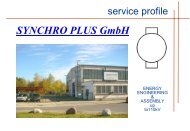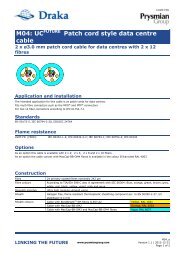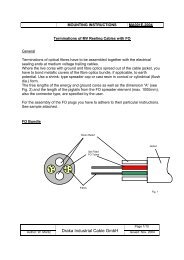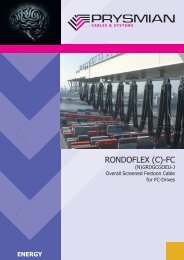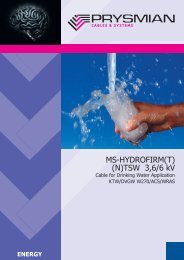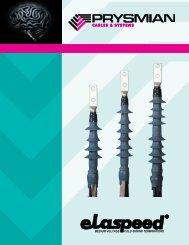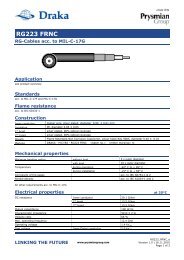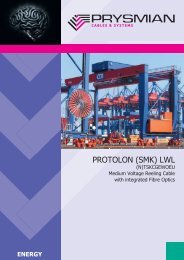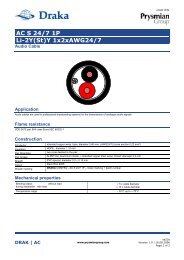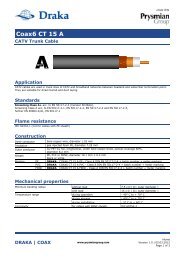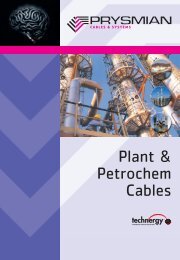Download 33kv Copper Cables Brochure - Prysmian
Download 33kv Copper Cables Brochure - Prysmian
Download 33kv Copper Cables Brochure - Prysmian
- No tags were found...
Create successful ePaper yourself
Turn your PDF publications into a flip-book with our unique Google optimized e-Paper software.
TECHNICAL INFORMATIONCURRENT RATINGSThe current ratings indicated in this manual have beenbased on the calculation procedures as recommendedin IEC 60287 and the following assumptions. Ratingfactors should be applied to cover any variation.• Max. continuous conductor temp. = 90°C• Ambient air temperature = 40°C• Ambient ground temperature = 25°C• Depth of laying = 0.8m• Thermal resistivity of soil = 1.2°C.m/W• Balanced load, comprising either a single three corecable or three single core cables, in trefoil formationtouching throughout, with the screens bonded at bothends of the route.• Installation conditions:1. Direct Buried:<strong>Cables</strong> are installed direct in the ground, withsuitable compacted backfill2. Buried Singleway Ducts:<strong>Cables</strong> are installed with one cable per duct3. In Free Air:<strong>Cables</strong> installed shielded from direct sunlight andwith a minimum clearance from any vertical wallof 0.3xCable Dia. and 0.5xCable Dia. for single andthree core cables respectively to ensure free aircirculation.In order to select the appropriate cable for a givenapplication, consideration must be given to the natureof the installation. It is not possible to provide adefinitive guide to specifying the correct cable typefor every situation, this choice must be made by thespecifier and/or installer based upon a knowledgeof the installation, applicable regulations and thecharacteristics of available cable designs. Generalguidance on the use of cable types included has beengiven above, but for further information and guidance itis recommended to make reference to the appropriatecable standard (e.g. AS/NZS 1429.1 or AS/NZS 4026).TEMPERATURE LIMITSIn respect of thermal effects the temperature limit givenfor each cable type is the maximum temperature due toany combination of the heating effect of current in theconductors and ambient conditions. All insulation andsheathing materials become stiffer as their temperatureis lowered and due regard has been taken of this factorin the guidance on minimum installation temperature.The materials used for these cables are compatible withtemperatures of 90ºC for continuous operation and250ºC for short circuit conditions of up to 5 seconds.The fault ratings for the conductors and the metallicscreens are provided for a time period of 1 second. Whenother times (t) between 0.2 and 5 seconds are required,the appropriate rating may be obtained by multiplyingthe 1 second rating by the factor: 1/√t.The ratings for the screens are based upon thetraditional adiabatic method, which provides asubstantial safety margin when account is taken ofthe heat loss occurring in practice. The non-adiabaticmethod to IEC standards can be used according toAS/NZS 1429.1 when agreed between the purchaser andsupplier. This can provide substantial systems savings.Short circuit capacity that is related to the energyexpended during a short circuit. It is equated tothe mass x specified heat capacity x temperaturechange in the conductor. Two types of conditionshave to be considered – symmetrical and earth shortcircuit currents. Various cable designs have differentnominated maximum temperatures after shortcircuit, depending usually on the type of insulationand sheathing, and these temperatures should not beexceeded.Economics important criteria related to cable economicsare the initial system cost and annual cost of losses.Economics are generally considered on a present valuecalculation based on initial cost and discounted cost oflosses. Data provided in the tables assists specifiers toestimate purchase and running costs.135



